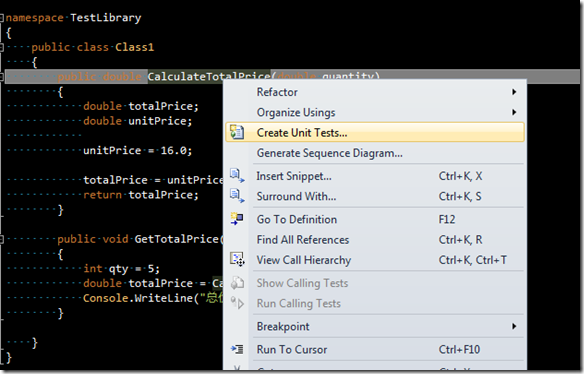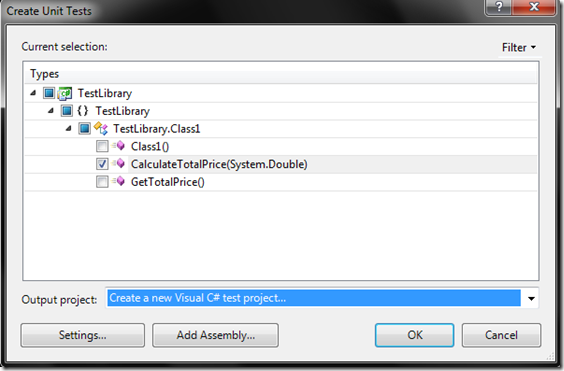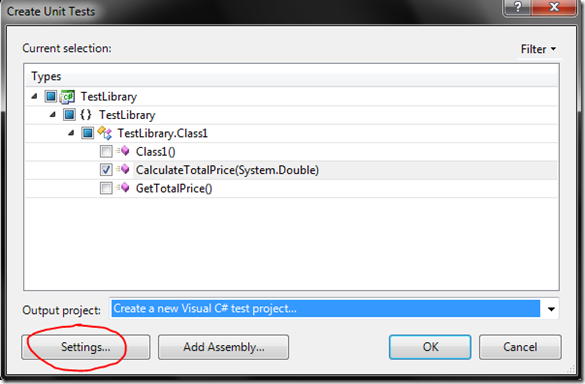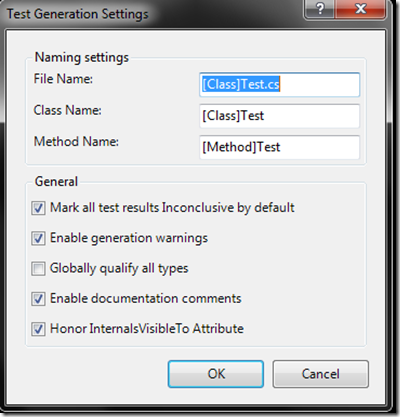VS2010中的自动化测试(2)——单元测试
来源:互联网 发布:沙画软件 编辑:程序博客网 时间:2024/06/07 02:37
概述
在软件开发过程中,我们可能会有很多的模块,而每个模块有可能又由许多函数组成。当我们的系统发生错误时,我们必须定位发生错误的模块,然后精确到模块中某个具体的函数中,而这工作往往又是非常浪费时间和生产效率的,如果系统越复杂,那么定位错误的成本将越高。所以在每个函数集成进模块时,必须通过严格的单元测试来验证。
在VS2010中我们可以为我们的函数自动生成单元测试,无论它是否是public或者的private的。所有用于单元测试的类和函数都被定义在Microsoft.VisualStudio.TestTools.UnitTesting这个命名空间中。
创建Unit Test
我们先创建一个被测试的类库工程,名字叫TestLibrary,然后添加如下代码:
using System;using System.Collections.Generic;using System.Linq;using System.Text;namespace TestLibrary{ public class Class1 { public double CalculateTotalPrice(double quantity) { double totalPrice; double unitPrice; unitPrice = 16.0; totalPrice = unitPrice * quantity; return totalPrice; } public void GetTotalPrice() { int qty = 5; double totalPrice = CalculateTotalPrice(qty); Console.WriteLine("总价: " + totalPrice); } }}
然后我们在需要单元测试的函数上鼠标右键,如图会有个Create Unit Tests选项。

点击该选项后,就会弹出如下窗口,该窗口会显示出该工程和类中所有的函数,这里我们可以选择我们要进行单元测试的函数。

我们选择CalculateTotalPrice和GetTotalPrice两个函数,点击OK,然后输入测试工程的名字点Create。(我们可以在Output project选项中选择一个以创建的工程或者创建一个新的测试工程)我们的单元测试代码就自动创建好了,当然,这个自动创建的测试代码并没有完成的,而是为我们的单元测试搭好了框架而已。自动生成的代码如下:
using TestLibrary;using Microsoft.VisualStudio.TestTools.UnitTesting;using System;namespace TestProject1{ ///<summary> ///This is a test class for Class1Test and is intended ///to contain all Class1Test Unit Tests ///</summary> [TestClass()] public class Class1Test { private TestContext testContextInstance; ///<summary> ///Gets or sets the test context which provides ///information about and functionality for the current test run. ///</summary> public TestContext TestContext { get { return testContextInstance; } set { testContextInstance = value; } } #region Additional test attributes // //You can use the following additional attributes as you write your tests: // //Use ClassInitialize to run code before running the first test in the class //[ClassInitialize()] //public static void MyClassInitialize(TestContext testContext) //{ //} // //Use ClassCleanup to run code after all tests in a class have run //[ClassCleanup()] //public static void MyClassCleanup() //{ //} // //Use TestInitialize to run code before running each test //[TestInitialize()] //public void MyTestInitialize() //{ //} // //Use TestCleanup to run code after each test has run //[TestCleanup()] //public void MyTestCleanup() //{ //} // #endregion ///<summary> ///A test for CalculateTotalPrice ///</summary> [TestMethod()] public void CalculateTotalPriceTest() { Class1 target = new Class1(); // TODO: Initialize to an appropriate value double quantity = 0F; // TODO: Initialize to an appropriate value double expected = 0F; // TODO: Initialize to an appropriate value double actual; actual = target.CalculateTotalPrice(quantity); Assert.AreEqual(expected, actual); Assert.Inconclusive("Verify the correctness of this test method."); } ///<summary> ///A test for GetTotalPrice ///</summary> [TestMethod()] public void GetTotalPriceTest() { Class1 target = new Class1(); // TODO: Initialize to an appropriate value target.GetTotalPrice(); Assert.Inconclusive("A method that does not return a value cannot be verified."); } }}
其实,我们可以在创建单元测试时适当控制自动生成的测试代码,如图我们点击Setting按钮。

这时会弹出如下图的窗口

在该对话框中,我们可以对生成的测试文件、测试类以及测试方法自定义名称。
- Mark all test results Inconclusive by default:选中该复选框可为每个测试方法提供 Assert.Inconclusive() 语句作为占位符 Assert。清除该复选框可消除占位符 Assert。
- Enable generation warnings:在测试函数创建中如果遇到任何的错误,代码生成器会将这些错误信息以注释的形式写在生成的代码中。
- Globally qualify all types:这个选项是用来解决多个类可能有相同名字的函数问题,单元测试文件可能包含有多个类的测试函数,所以有可能会有同名的冲突,所以为了区分开同名的函数,会在测试命名中添加namespaces。
- Enable documentation comments:选中此复选框可为每个测试方法提供占位符注释。清除该复选框可消除占位符注释。
- Honor InternalsVisibleTo Attribute:选中该复选框可使标为 Friend 或 Internal 的方法被视为公共方法(推荐)。清除该复选框则需要使用专用访问器测试这些方法。
此外还可以注意到自动生成的代码中有一些被注释的方法,这些方法我们可以选择使用:
- [ClassInitialize()]标记的方法可在运行类中的第一个测试前运行代码。
- [ClassCleanUp()]标记的方法可在运行完类中的所有测试后运行代码。
- [TestInitialize()]标记的方法可在运行每个测试前运行代码。
- [TestCleanUp()]标记的方法可在运行完每个测试后运行代码。
Assert语句
Assert语句用来比较从方法返回来的值和期望值,然后返回pass或者fail的结果。如果在一个测试方法中有多个Assert的话,那么这个测试方法要通过测试必须让所有的Assert方法通过,不然,其中有一个fail,那么这个Case就会fail。如果我们的单元测试中没有任何的Assert语句,那么它的结果始终是pass的。
Assert类有许多进行比较的方法,此外还有StringAsserts、CollectionAssert类也可用于单元测试中,具体的我们可以参加MSDN上的介绍了。
下面我们修改一下CalculateTotalPriceTest()这段测试代码,并将最后的Assert.Inconclusive注释:
[TestMethod()] public void CalculateTotalPriceTest() { Class1 target = new Class1(); double quantity = 10F; double expected = 160F; double actual; actual = target.CalculateTotalPrice(quantity); Assert.AreEqual(expected, actual); //Assert.Inconclusive("Verify the correctness of this test method."); }
最后我们可以在该函数中,右键鼠标然后点击Run Tests运行测试一下我们的代码。我们就可以在Test Results窗口中看见我们运行的结果。
- VS2010中的自动化测试(2)——单元测试
- VS2010中的自动化测试(2)——单元测试
- VS2010中的自动化测试(2)——单元测试
- VS2010中的自动化测试(3)——数据驱动的单元测试
- VS2010中的自动化测试(3)——数据驱动的单元测试
- VS2010中的自动化测试(3)——数据驱动的单元测试
- VS2010中的自动化测试(1)——VS2010中的测试管理工具
- VS2010中的自动化测试(1)——VS2010中的测试管理工具
- VS2010中的自动化测试(1)——VS2010中的测试管理工具
- VS2010中的自动化测试(1)——VS2010中的测试管理工具
- VS2010中的自动化测试(2)——Web性能测试
- VS2010中的自动化测试
- VS2010中的自动化测试(4)——Web性能测试
- VS2010中的自动化测试(4)——Web性能测试
- VS2010中的自动化测试(4)——Web性能测试
- Android自动化测试——java test unit(单元测试)
- 单元测试和测试自动化
- 自动化测试 - 单元测试
- Android支持的音频格式
- Csharp run sql script create database
- HDU 2115 I Love This Game
- xwork.xml配置文件
- JavaScript数组定义
- VS2010中的自动化测试(2)——单元测试
- Java文件读取
- Android mdpi ldpi hdpi区别(转)
- 详细介绍C/C++时间函数使用方法
- 给UIImageView加手势
- Android支持的媒体格式
- Integer等默认对象作函数参数时,亦是传值而非传址
- VS2010中的自动化测试(1)——VS2010中的测试管理工具
- 对象模型



